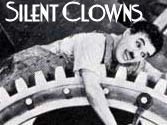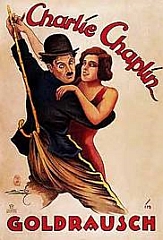CITY LIGHTS
(1931)With Charles Chaplin, Virginia Cherrill, Harry Myers, Hank Mann, Florence Lee, Henry Bergman, Al Ernest Garcia
Written and Directed by Charles Chaplin
Silent with music and soudn effectseffects soundtrack, Black and White
Reviewed by JB
 By the time Chaplin released CITY LIGHTS, the movies had been talking,
with a vengeance, for several years. Buster Keaton's enormous
talent was already
being wasted in sound films, and Harold Lloyd had
released his first two and was filming his third. The Marx
Brothers had come from
Broadway to bring a new style of verbal and visual comedy to
the
screen, and Laurel and Hardy had successfully made the transition from
silent to sound to become even more popular than ever. By
1931, silent films and silent comedy was essentially dead.
By the time Chaplin released CITY LIGHTS, the movies had been talking,
with a vengeance, for several years. Buster Keaton's enormous
talent was already
being wasted in sound films, and Harold Lloyd had
released his first two and was filming his third. The Marx
Brothers had come from
Broadway to bring a new style of verbal and visual comedy to
the
screen, and Laurel and Hardy had successfully made the transition from
silent to sound to become even more popular than ever. By
1931, silent films and silent comedy was essentially dead.
Like Harold Lloyd, Chaplin still had the star power and financial ability to call his own shots and so decided his Little Tramp would remain silent. CITY LIGHTS, a silent film (no spoken dialogue) with a musical score and sound effects, was a huge success in its day and remains one of most touching movies of all time. In CITY LIGHTS, the Tramp falls in love with a blind flower girl, and eventually provides the means for her to regain her eyesight via an operation. Although this is the story most people remember, most of the film revolves around his friendship with a drunken millionaire, who treats Charlie as a bosom buddy when drunk and as a complete stranger when sober. Harry Myers is a perfect screen companion for Chaplin, and the film is at its funniest whenever the two best friends are gallivanting around town at nightclubs and parties. The boxing sequence, in which Charlie attempts to win a cash prize by taking on the rock-ribbed Hank Mann in the ring, is also a major highlight.
The film lags a bit in the middle with some throwaway sequences of Charlie working as a street cleaner to earn money for the blind girl, but the ending is considered to be one of the best, and most ambiguous, of all time. Returning to the streets after a stint in jail, the Tramp is no longer a figure of fun, but a sad, pathetic scrap of a human being. The blind girl, now able to see thanks to him, runs a successful flower shop and waits for her mysterious benefactor, whom she has never seen but only touched, to return. Without spoiling the rest of it for those who haven't seen the film, I can only say this: when the Tramp sees the blind girl after her operation, you will see some of Chaplin's finest acting.
If you've never seen a silent
comedy before, I recommend you start with Harold
Lloyd's
SAFETY LAST,
Buster Keaton's THE
GENERAL and, to top it off,
Chaplin's CITY LIGHTS . And bring a
hankie for that last scene.  ½
- JB
½
- JB


